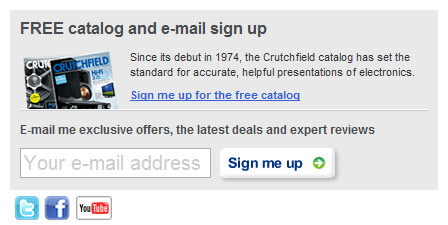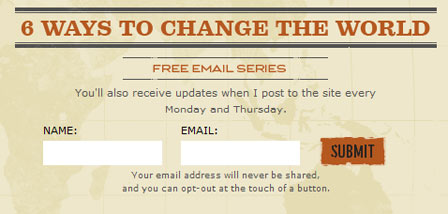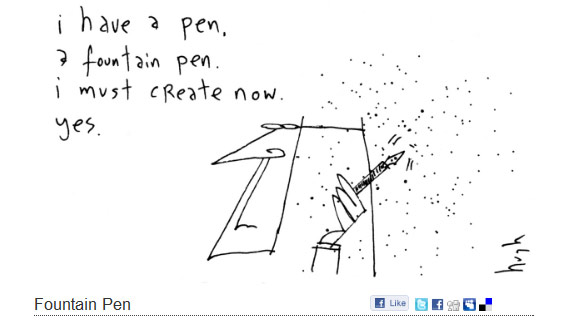A Beginner’s Successful Guide to Email Marketing
Do you remember hearing that? It’s one of those legendary pieces of Internet history formed when the road was still being paved and we were foraging our way through the wilderness of what was the original World Wide Web.
Although times have changed and AOL no longer sends CD’s in the mail, we can still thank them for introducing us to email and our addiction to it.
These days, we’ve replaced that message with Tweets, likes, and status updates, but that doesn’t mean that our affinity for email is any less. In fact, because of the noise that is social media, one could argue that the inbox has become our virtual dojo, our place of solitude amongst the chaos.
This is why, as an entrepreneur, I believe that building successful email marketing campaigns has never been more important than it is now. But there’s a problem; most people don’t know how to do it right. So in the interest of furthering best practices and helping you succeed as a business owner, let’s get back to the basics and talk about how a great email campaign is built, from the ground up.
You’re in their house
People are inundated with interruption, pitches, and advertisements everywhere they look, and though you might think yours is special, there’s a high probability that to the reader, it looks the same as the rest. This is why it’s important to remember where you are, and use your good manners as a result.
Getting into someone’s inbox is like being invited to their home for dinner. If they ask you to take your shoes off, you respectfully do so. It’s the same with email marketing, so before we begin I’d simply like to remind you to be on your best behavior at all times and remember…you’re in their house.
Phase I: Getting Permission
Of course, no email campaign was ever built without getting permission to get started, so first we’ll need to focus on building a sizable email list.
There are many ways you can do this of course. Some prefer to give something away for free while others simply offer a newsletter or product updates.
I can’t tell you which is the right or wrong answer in this case, but I can tell you that it’s important to have a clear purpose when asking for an address. This is where a strong call to action comes into play, and copywriting is super important.
- What do I get when I give you my email address?
- Are you going to spam me?
- How often will you email me?
- Will I get discounts?
- Will I get a first crack at your beta?
- Will you send me relevant offers or more junk?
These are the kinds of things you’ll need to address if you want to be successful in phase 1. Simply posting “enter your email for updates” isn’t going to get anyone excited to do so. Instead, consider sharing specifics:


Note the Clear and Concise Call to Action in the Examples Above
Take a look at the examples above and you’ll see that the first tells me I’m getting a free catalogue and a series of reviews and special offers, while the 2ndtells me exactly when I’ll receive the newsletter updates. This is a far more specific, and effective, way of doing business.
A quick look at my own practices tells me that the offers I subscribe to most often are for:
- Email Series’ (i.e. 6 Ways to Change the World)
- Free Downloads
- Free White Papers or eBooks
- Update Lists (New Issue Notifications, Product Updates, New Releases)
Lastly, and Amazon does this really well, your customers make great candidates, so don’t forget to integrate some form of registration or email subscription as part of your purchasing process. Just remember to treat these addresses with special regard, which we’ll talk about in phase 2.
Get Whitelisted
While almost all reputable email service providers work very hard to make sure that your emails are not blocked by major ISP’s, they can’t control whether or not your emails hit the inbox or the spam box. Although most will help you by providing a quality score to help you determine availability, getting whitelisted is the most effective way to ensure that your emails get delivered properly.
Essentially, getting whitelisted is equivalent to being marked as a friend, and the best way to achieve this is by being added to the recipient’s address book. The best way to do this is by providing instructions to do so at the top of each email, especially on the initial thank you and first follow-up email.
Furthermore, here are instructions from some of the more popular online providers:
- AWeber
- Mailchimp
- Constant Contact
- Campaign Monitor
- Blue Sky Factory
- Emma
Phase II: Playing the Numbers Game
Manage Expectations with Follow-Up Efforts
Email marketing is all about expectations, and it’s up to you to set them. If your call to action is strong, and your follow-up is consistent, then you can count on a positive campaign. However, if you promise to send one email per week and instead send them daily, then you’re setting yourself up for failure. On the contrary, if someone is expecting daily updates or critical product updates and you don’t’ deliver, then they are likely to be just as upset in that case too.

Because I asked, I expect Hugh MacLeod to email his cartoons daily.
This is why the first follow-up email is so crucial to the success of your email marketing efforts. Almost all email service providers give you the option to create an autoresponder sequence, and it’s imperative that you take advantage of it.
The initial follow-up email should be sent immediately as a way to introduce yourself and detail what you plan on doing with your new subscriber’s email address. It’s better to be long-winded and detailed than it is to be quick and unobtrusive, but if you can pull off quick and concise then more power to you.
From here, it’s simply a matter of living up to their expectations.
When to Pitch
If you’re going to get in the habit of pitching often, try to put yourself in the reader’s shoes. Ask yourself if your messaging is consistent with the expectations you’ve set. As I said before, Amazon does this well because they send relevant offers based on my buying habits. Those that send blind offers are far more likely to lose permission to keep doing so.










No comments: